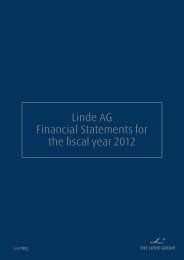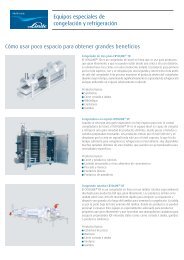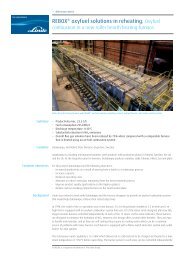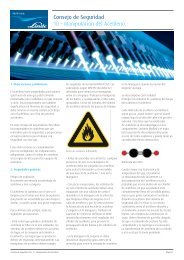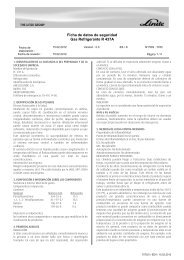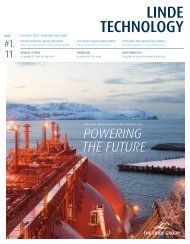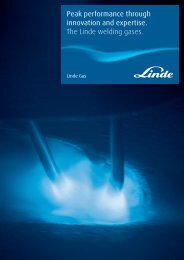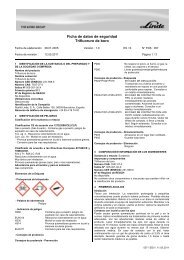Linde in Solar. - Linde Gas
Linde in Solar. - Linde Gas
Linde in Solar. - Linde Gas
You also want an ePaper? Increase the reach of your titles
YUMPU automatically turns print PDFs into web optimized ePapers that Google loves.
<strong>L<strong>in</strong>de</strong> <strong>in</strong> <strong>Solar</strong>05Th<strong>in</strong> Film Si technology is grow<strong>in</strong>g rapidly.OEM AOEM BOEM CBulk <strong>Gas</strong>(N 2& H 2)OthersOthers3% SiH 414%16%SiH 4Dopants21%31% Bulk41%<strong>Gas</strong>es(N 2,Ar,H 2)39%31%3%39%SiH 425%NF 3TCOPrecursorsNF 337%Nextgeneration precursorsRelative proportions of process gases for 3 different equipment setsIn order to reduce the cost per watt, <strong>L<strong>in</strong>de</strong> has moved from ‘traditionalsupplier’ to becom<strong>in</strong>g an <strong>in</strong>tegral part of the photovolaic <strong>in</strong>dustry.<strong>L<strong>in</strong>de</strong>’s people understand the critical manufactur<strong>in</strong>g processes andare develop<strong>in</strong>g <strong>in</strong>novative gas and chemical technologies to lowerthe overall cost per watt. These cost reduction technologies will have<strong>in</strong>creas<strong>in</strong>g impact as the <strong>in</strong>dustry moves to ever larger manufactur<strong>in</strong>gscale.The critical process step <strong>in</strong> all th<strong>in</strong> film silicon technologies is depositionof doped silicon film from a silane precursor <strong>in</strong> a Plasma EnhancedChemical Vapor Deposition (PECVD) system. The result is a th<strong>in</strong> film ofsilicon on the glass. Typically hydrogen is also <strong>in</strong>troduced to controlthe k<strong>in</strong>etics of the film growth. Dopants are <strong>in</strong>corporated throughprecursors such as trimethyl boron (TMB), diborane (B 2 H 6 ), phosph<strong>in</strong>e(PH 3 ) and methane (CH 4 ).This process also results <strong>in</strong> silicon deposition on other surfaces <strong>in</strong> theprocess chamber such as the showerhead and chamber walls, whichmust be periodically cleaned. Typically a fluor<strong>in</strong>e-based etch processus<strong>in</strong>g NF 3 , SF 6 or F 2 is employed for this purpose.Nitrogen is a critical utility <strong>in</strong> th<strong>in</strong> film Si fabs and is used for multipletasks <strong>in</strong>clud<strong>in</strong>g purg<strong>in</strong>g vacuum pumps and dilution of toxic orflammable gases <strong>in</strong> chamber exhaust l<strong>in</strong>es for safety.Another important step is the deposition of a transparent conductiveoxide (TCO) film on the front glass. This is typically t<strong>in</strong> oxide or z<strong>in</strong>coxide deposited via sputter<strong>in</strong>g or us<strong>in</strong>g an organometallic precursorsuch as diethyl z<strong>in</strong>c (DEZ).<strong>Gas</strong> cost reductions are possible by a variety of methods, such as:On site generation of bulk gasesThe economics of large scale fabrication plants favour on sitegeneration of major bulk gases such as hydrogen and nitrogen. Thiselim<strong>in</strong>ates the transportation and delivery cost of cyl<strong>in</strong>ders andenhances security of supply.Lower<strong>in</strong>g Clean<strong>in</strong>g CostsMore than 50% of the capital cost and over 40% of the direct materialscost is consumed <strong>in</strong> the PECVD processes that deposit the active siliconlayers. The PECVD chambers require frequent clean<strong>in</strong>g of silicon residue.Replac<strong>in</strong>g current methods (NF 3 or SF 6 ) by fluor<strong>in</strong>e (F 2 ) can improveclean<strong>in</strong>g economics by up to 40%. Fluor<strong>in</strong>e is generated on-site us<strong>in</strong>gpackaged fluor<strong>in</strong>e generators.Increas<strong>in</strong>g ThroughputBy utiliz<strong>in</strong>g fluor<strong>in</strong>e based clean<strong>in</strong>g the throughput of the PECVD processmay be <strong>in</strong>creased by up to 6% at no extra cost. Additives <strong>in</strong> silane may<strong>in</strong>crease deposition rates and thereby <strong>in</strong>crease throughput.Improv<strong>in</strong>g cell efficiencyThe cell efficiency is strongly affected by the composition of the activep-i-n layers <strong>in</strong> the amorphous and microcrystall<strong>in</strong>e steps. The cellefficiency may be improved by controll<strong>in</strong>g critical impurities <strong>in</strong> theprecursor gases.<strong>L<strong>in</strong>de</strong>’s PV technology development roadmap targets each of theseareas, and many more. In every case, <strong>L<strong>in</strong>de</strong>’s approach <strong>in</strong>volvesclose collaboration with key members of the technology value cha<strong>in</strong>,<strong>in</strong>clud<strong>in</strong>g suppliers, PV equipment manufacturers and customers. Thisclose <strong>in</strong>tegration with the <strong>in</strong>dustry and alignment of research anddevelopment goals with the primary objective of reduc<strong>in</strong>g cost per watthave been critical factors <strong>in</strong> conv<strong>in</strong>c<strong>in</strong>g more than half of all th<strong>in</strong> film Simanufacturers globally that <strong>L<strong>in</strong>de</strong> is the gas partner of choice for them.




